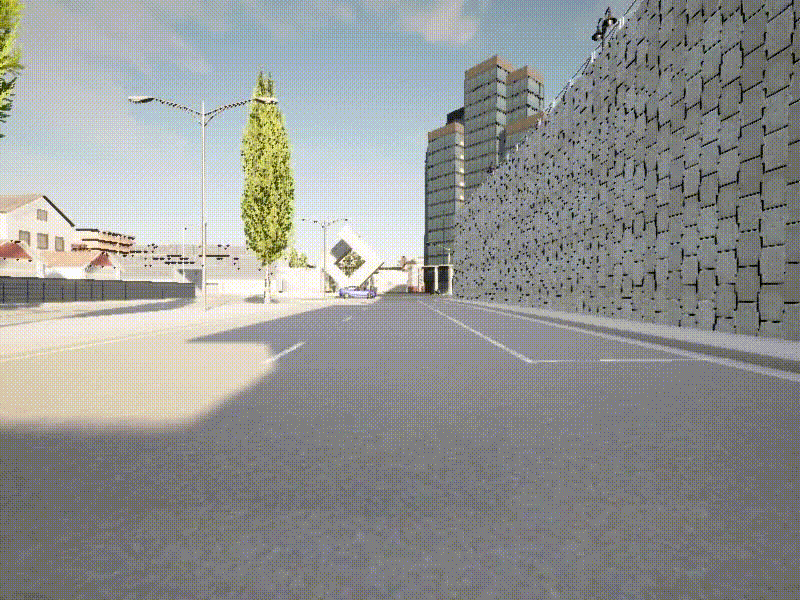yolop operator
yolop recognizes lanes, and drivable area from a specific images.
More info here: https://github.com/hustvl/YOLOP
You can also choose to allocate the model in GPU using the environment variable:
PYTORCH_DEVICE: cuda # or cpu
Inputs
- image: HEIGHT x WIDTH x BGR array.
Outputs
- drivable_area: drivable area as contour points
- lanes: lanes as 60 points representing the lanes
Example plot ( lanes in red, drivable area in green)

Graph Description
- id: yolop
operator:
outputs:
- lanes
- drivable_area
inputs:
image: webcam/image
python: ../../operators/yolop_op.py
Methods
__init__()
Source Code
def __init__(self):
self.model = torch.hub.load("hustvl/yolop", "yolop", pretrained=True)
self.model.to(torch.device(DEVICE))
self.model.eval()
.on_event(...)
Source Code
def on_event(
self,
dora_event: dict,
send_output: Callable[[str, bytes], None],
) -> DoraStatus:
if dora_event["type"] == "INPUT":
return self.on_input(dora_event, send_output)
return DoraStatus.CONTINUE
.on_input(...)
Source Code
def on_input(
self,
dora_input: dict,
send_output: Callable[[str, bytes], None],
) -> DoraStatus:
# inference
frame = cv2.imdecode(
np.frombuffer(
dora_input["data"],
np.uint8,
),
-1,
)
frame = frame[:, :, :3]
h0, w0, _ = frame.shape
h, w = (640, 640)
frame, _, (pad_w, pad_h) = letterbox_for_img(frame)
ratio = w / w0
pad_h, pad_w = (int(pad_h), int(pad_w))
img = torch.unsqueeze(transform(frame), dim=0)
half = False # half precision only supported on CUDA
img = img.half() if half else img.float() # uint8 to fp16/32
img = img.to(torch.device(DEVICE))
det_out, da_seg_out, ll_seg_out = self.model(img)
# det_out = [pred.reshape((1, -1, 6)) for pred in det_out]
# inf_out = torch.cat(det_out, dim=1)
# det_pred = non_max_suppression(
# inf_out,
# )
# det = det_pred[0]
da_predict = da_seg_out[:, :, pad_h : (h0 - pad_h), pad_w : (w0 - pad_w)]
da_seg_mask = torch.nn.functional.interpolate(
da_predict, scale_factor=1 / ratio, mode="bilinear"
)
_, da_seg_mask = torch.max(da_seg_mask, 1)
da_seg_mask = da_seg_mask.int().squeeze().cpu().numpy()
da_seg_mask = morphological_process(da_seg_mask, kernel_size=7)
contours, _ = cv2.findContours(
da_seg_mask, cv2.RETR_EXTERNAL, cv2.CHAIN_APPROX_SIMPLE
)
if len(contours) != 0:
contour = max(contours, key=cv2.contourArea)
contour = contour.astype(np.int32)
send_output("drivable_area", contour.tobytes(), dora_input["metadata"])
else:
send_output("drivable_area", np.array([]).tobytes(), dora_input["metadata"])
ll_predict = ll_seg_out[:, :, pad_h : (h0 - pad_h), pad_w : (w0 - pad_w)]
ll_seg_mask = torch.nn.functional.interpolate(
ll_predict, scale_factor=1 / ratio, mode="bilinear"
)
_, ll_seg_mask = torch.max(ll_seg_mask, 1)
ll_seg_mask = ll_seg_mask.int().squeeze().cpu().numpy()
# Lane line post-processing
ll_seg_mask = morphological_process(
ll_seg_mask, kernel_size=7, func_type=cv2.MORPH_OPEN
)
ll_seg_points = np.array(connect_lane(ll_seg_mask), np.int32)
send_output("lanes", ll_seg_points.tobytes(), dora_input["metadata"])
return DoraStatus.CONTINUE